The latest online predator statistics reveal that half a million of these perpetrators are a threat to children on any given day. Their most likely victims are females aged 12-15, which they find on social media.
Read on for the details.
How many predators are online daily?
- It’s estimated that, at any given time, there are 500,000 internet predators actively pursuing children through multiple online profiles.
- There are estimates of as many as five million predators on the internet.
Online Predators and Their Victims
- Online predator stats reveal that 20% of kids have been sexually solicited online.
- 75% of them didn’t tell a parent about it, and as much as 90% of parents will never know of such inappropriate contact.
- 14% of kids have met online predators in person, and nearly 75% of them did so more than once.
- Sex offender statistics reveal that as many as 85% of online predators are hands-on abusers of children.
At 22.5%, online solicitation is the most common sex offense against children on the internet.
According to facts about online predators, online sexual abuse ranks second, with 15.6% of victims having experienced it, followed by image-based sexual abuse, with 11%.
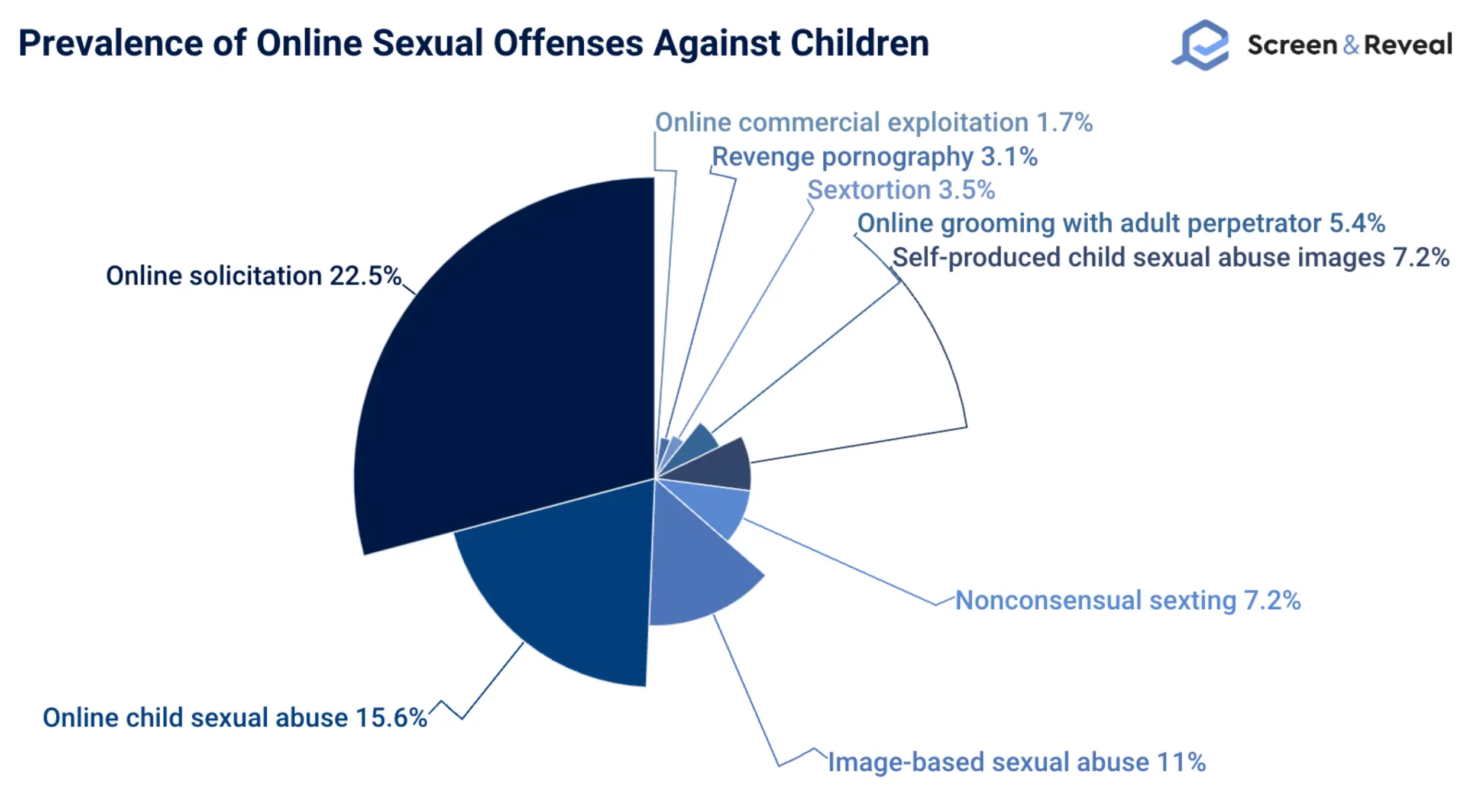
At 18.8%, unwanted sexual questions are the most common component of online sexual abuse against children.
Unwanted sexual talk (16.9%) and unwanted sexual act requests (14.3%) follow, along with forced images (10.3%) and voluntary adult partners (8.6%).

At 60%, the most common goal of internet predators is to obtain sexually explicit content of children.
Pedophile statistics reveal that, in 32% of cases, the goal is to meet and have sexual contact with children. Engaging in sexual conversation/roleplay with children is the goal in 8% of cases, while 2% of online child predators have financial goals.
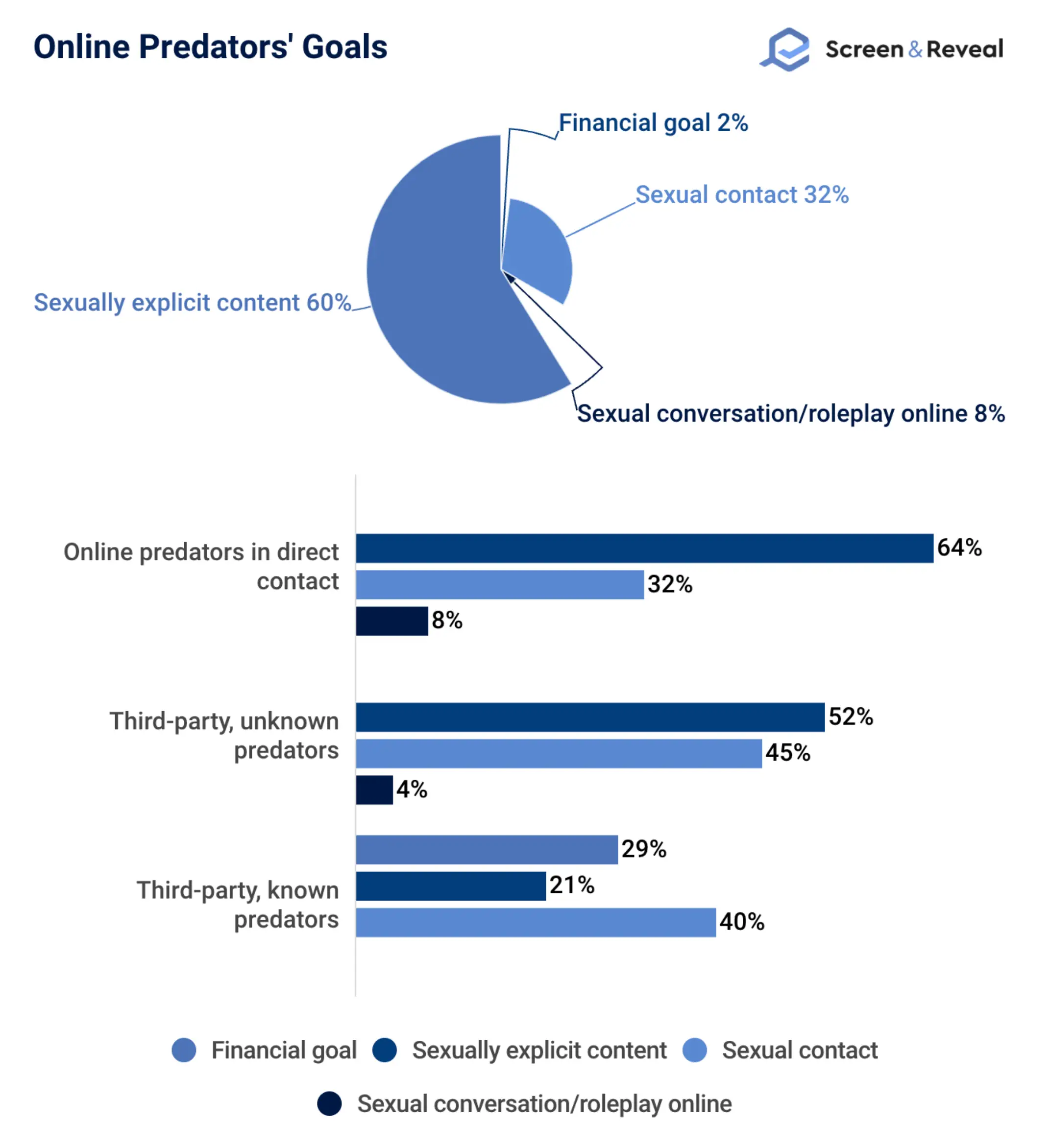
Online grooming statistics reveal that, in 34% of cases, cyber predators engage children in sexual conversation/roleplay as a grooming method, rather than a goal.
In 33% of cases, they ask children for sexually explicit photos of themselves, and in 23%, internet predators send unprompted sexually explicit photos of themselves.
Online child predators offer such photos of themselves in 10% of cases, while in 9%, such content is sent in exchange (most often initiated by the offender, and often by children as a form of “self-protection”).
According to online predator facts, in 29% of cases, internet predators develop a positive rapport with children based on compliments, praise, “shared” interests, being caring, etc. In 20%, they pretend to be younger by either lying to children or providing false data when registering for the online platform.
Child predators on the internet offer financial incentives or promises to buy gifts or substances or provide necessities like housing or food in 8% of cases.
Catfishing statistics reveal that methods used in less than 5% of cases include pretending to be female, a modeling agent, or someone known to the child, as well as recording/taking photos of the child without their permission, using chatbots to likely reach a bigger number of victims, and asking children to rate (most likely) explicit images of child predators online.
66.7% of victims of online sex offenses against children are female.
31.1% are male, and 2.2% are transgender or gender fluid.
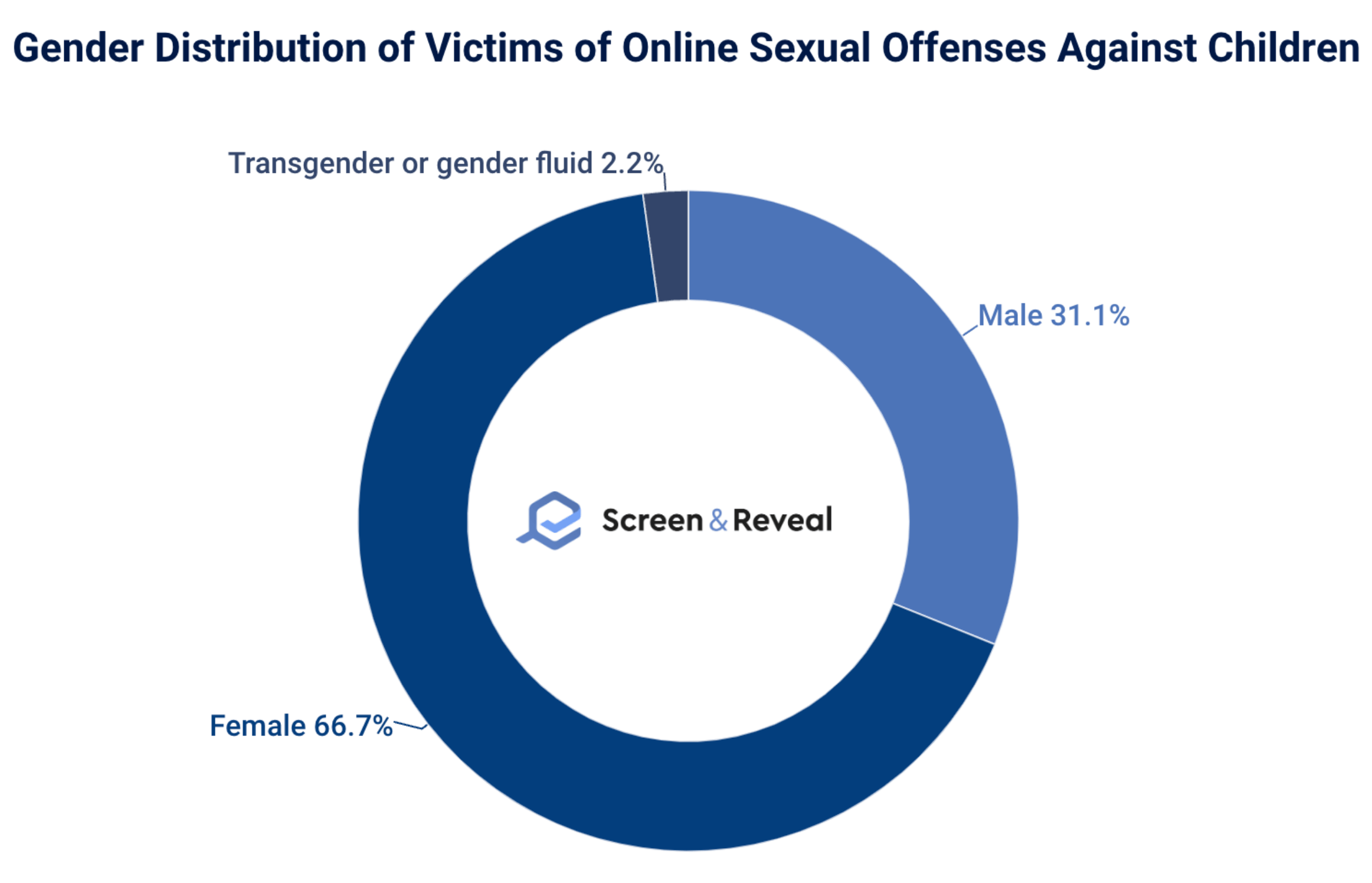
98% of cyber predators are people children don’t know in real life.
Cyber predators statistics reveal that, of the remainder, 53% are family members, and the most common among them are (step) parents (57%) and siblings (37%).
At 79.5%, online grooming with adult perpetrators is the most common online sex offense against children committed by perpetrators that victims know offline.
Revenge pornography ranks second with 76.6%, followed by nonconsensual sexting with 65.2%.
In cases of online grooming with adult perpetrators, the most common perpetrators are acquaintances, with 34.6%. In cases involving revenge pornography, intimate partners are the most likely perpetrators, with 50.1%.
At 74.8%, online solicitation is the most common online sex offense against children committed by unknown perpetrators.
Internet predator statistics reveal that online commercial exploitation ranks second with 65.1%, followed by sextortion with 40.6%.
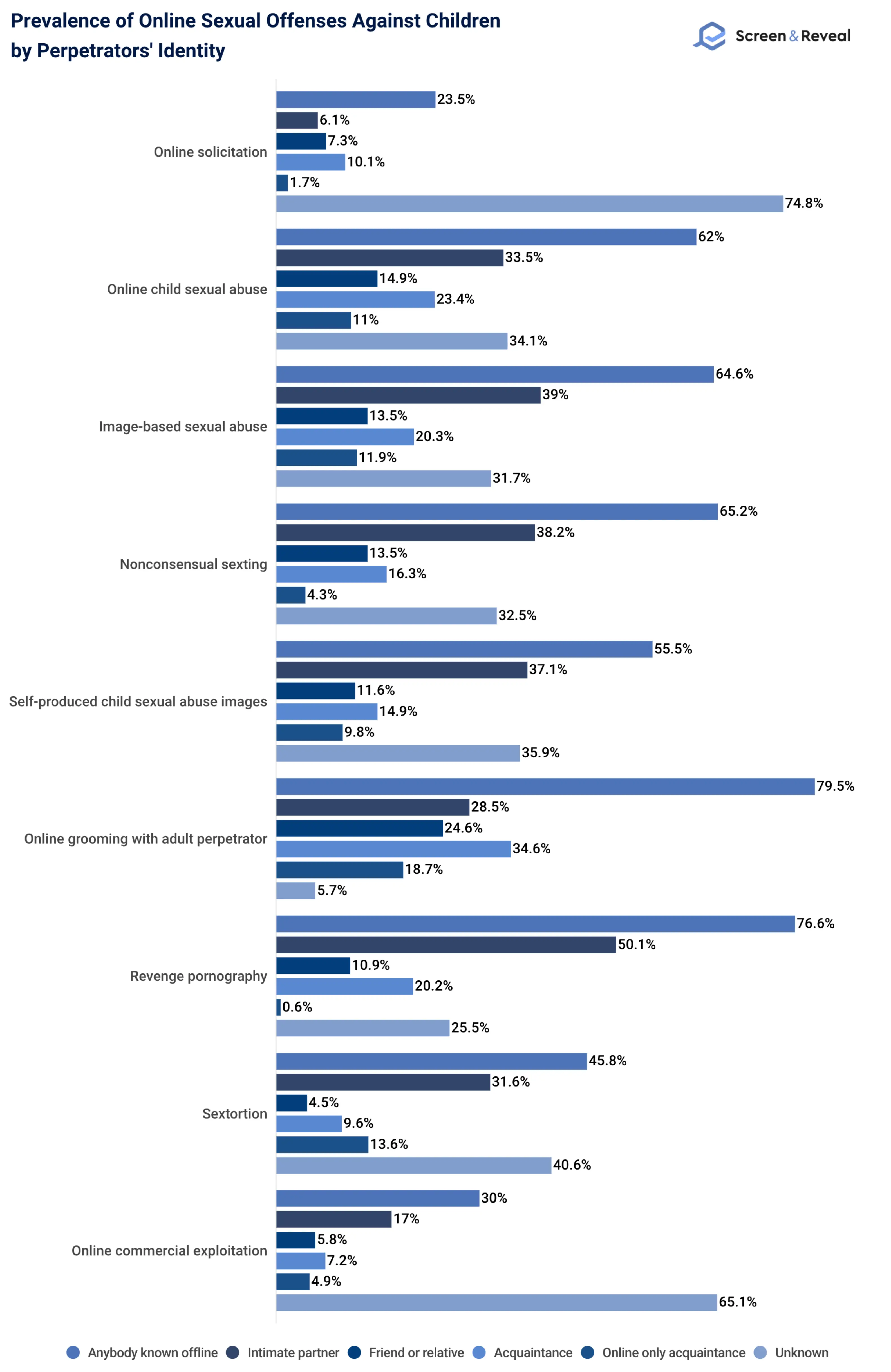
There were over 7,000 reports related to online financial sextortion of minors in 2022.
Received by the FBI, HSI, and NCMEC, the reports resulted in more than 3,000 victims and over a dozen suicides. FBI statistics on online predators reveal that, in most cases, child predators on the internet used fake female accounts to target 14-17-year-old boys. However, there were cases where victims were as young as ten.
What is the most common victim of online predators?
- More than half of victims of online predators are between 12 and 15 years old.
- 77% of online predators’ targets are 14 or older. 22% are between 10 and 13.
At 15.9%, online child sexual abuse is the most common online sexual offense against children aged 12 or younger.
According to facts on internet predators, nonconsensual sexting ranks second, with 13.1% of children aged 12 or younger that have been abused on the internet having experienced it.
Online solicitation follows with 12.9%, online grooming with adult perpetrators with 12.2%, and online commercial exploitation with 11.1%.
At 61.2%, self-produced child sexual abuse images are the most common online sexual offense against children aged 13-15.
Image-based sexual abuse ranks second, with 60.1% of children aged 13-15 that have been abused on the internet having experienced it.
Online child sexual abuse follows with 59.6%, nonconsensual sexting with 59.3%, and revenge pornography with 53.8%.
At 62.5%, online grooming with adult perpetrators is the most common online sexual offense against 16-17-year-old children.
Statistics of online predators reveal that image-based sexual abuse ranks second, with 60% of 16-17-year-old children that have been abused on the internet having experienced it.
Sextortion follows with 59.1%, online child sexual abuse with 58.1%, and self-produced child sexual abuse images with 55.1%.
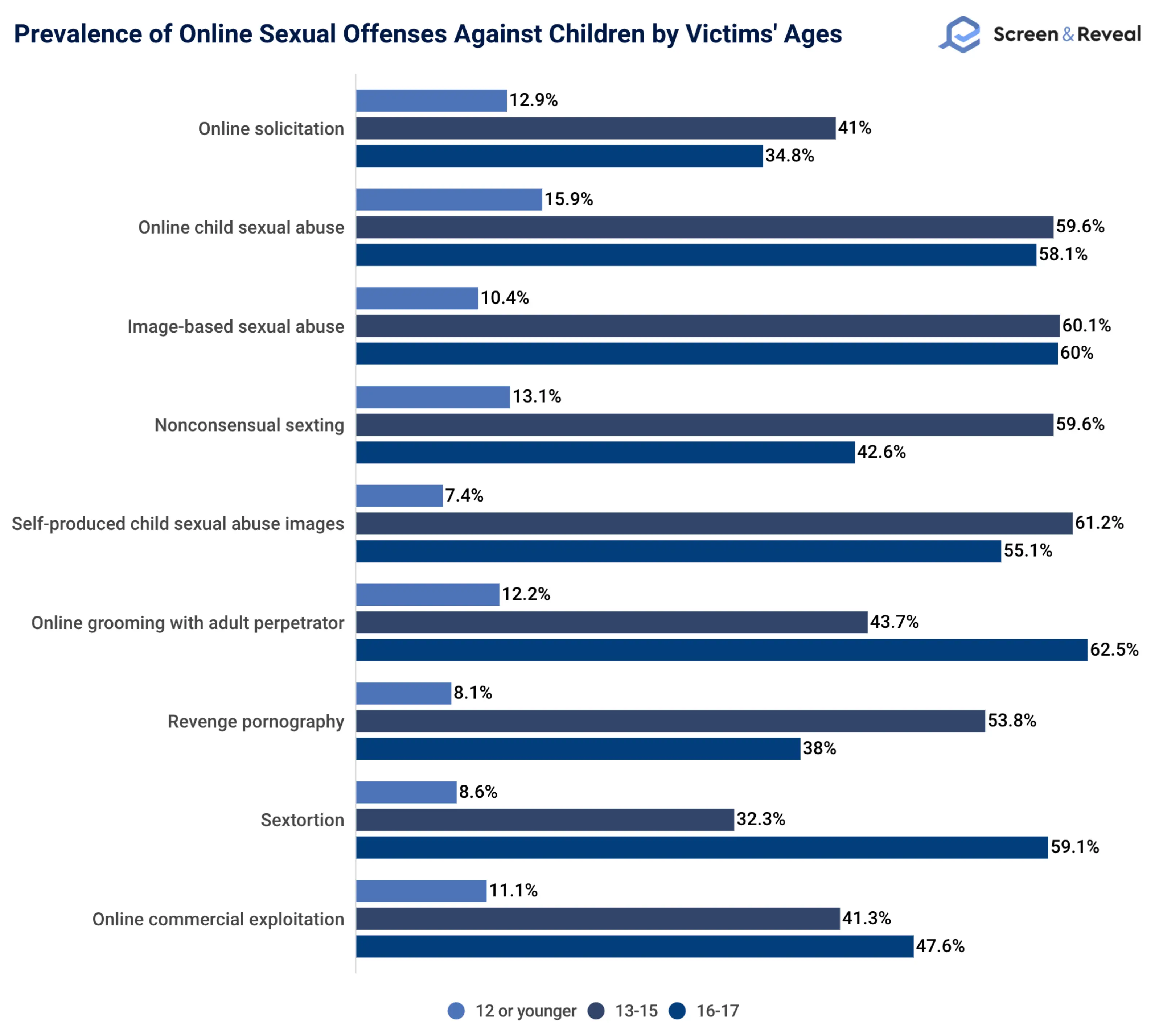
Where do online predators find their victims?
- Internet safety statistics reveal that as many as 89% of online predators’ victims are contacted through chatrooms and instant messaging.
- According to social media predators statistics, an estimated 82% of child sex crimes start with social media contact.
- Offenses involving grooming online occur on over 70 different apps and games. Most offenses involve the usage of multiple of these platforms.
- In 91% of cases, internet predators attempt direct, one-to-one communication with children. In 6%, they post online content as general solicitation for any child of a certain age or age range.
- In 74% of cases, child predators on the internet communicate with each other to offer or solicit specific children. In 13%, they post content to offer a child or content of it to others or solicit those with access to a child or content of it.
What social media has the most predators?
Meta-owned platforms (Facebook, Instagram, and WhatsApp) were used in 38% of recent cyber grooming cases combined. 33% of social media predators used Snapchat to commit their offenses.
39% of conversations between self-identified adults and supposed 13-year-old girls include an unsolicited link.
The above figure was obtained through a recent study of 953 conversations between self-identified adults and automated chatbots programmed as 13-year-old girls.
Online child predator statistics revealed that, of the unsolicited links sent, 41% were to Whereby, a Norwegian video conferencing platform, where the perpetrators attempted to entice the supposed girls to engage in inappropriate behavior.
A test conducted by a software developer revealed that a Whereby conversation host can embed code that allows them to turn on the visitor’s camera without their knowledge, which wasn’t the case with other major video conferencing platforms.
19% of links were embedded with malware to potentially compromise the child’s computer system and gain remote access to their webcam, and 5% led to phishing websites to potentially harvest the child’s personal information and aid the predator in victimizing them.
What age are internet predators?
Online predators are typically between 18 and 55 years old but can be younger or older than that.
At 51.7%, revenge pornography is the most common online sexual offense committed by perpetrators aged 18 or younger.
Facts about online predators reveal that nonconsensual texting ranks second with 46.6% of known perpetrators aged 18 or younger, followed by image-based sexual abuse with 39% and self-produced child sexual abuse images with 35.1%.
At 70.8%, online grooming with an adult perpetrator is the most common online sexual offense committed by perpetrators aged 18-25.
Online child sexual abuse ranks second with 36.2% of known perpetrators aged 18-25, followed by image-based sexual abuse with 31.4%.
At 26.4%, online grooming with an adult perpetrator is also the most common online sexual offense committed by perpetrators aged 26 or older.
Revenge pornography ranks second with 18.6% of known perpetrators aged 26 or older.
At 74.3%, online solicitation is the most common online sexual offense committed by unknown perpetrators.
According to online predator statistics, online commercial exploitation ranks second with 61% of unknown perpetrators of online sexual offense against children, followed by sextortion with 40.6%.

What are the types of online predators?
There are four types of online predators:
- The Gatherer, who collects media containing photographic or video pornography,
- The Producer, which distributes child pornography,
- The Talker, who targets victims in chat rooms, and
- The Voyager, whose aim is to meet their victim in person.
How many online child predators have been caught?
While there is no historical data on how many online child predators have been caught, a recent operation led by an LAPD task force resulted in 141 arrests over the course of a week.
Sources: CBS News, Child Rescue Coalition, Fast Company, FBI, JAMA Network, KOAA, NCMEC, NSPCC, Social Media Safety, uknowkids via Visual.ly, Zero Attempts

